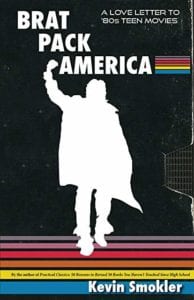
About the Book:
From the fictional towns of Hill Valley, CA, and Shermer, IL, to the beautiful landscapes of Astoria and Brownsville, OR, from the iconic suburbs of the San Fernando Valley to the seemingly scary inner cities of Chicago, ’80s teen movies had one thing in common: locations mattered. Perhaps moreso than in any other decade, the locations of the ’80s teen movies were monumentally important. In Brat Pack America, Kevin Smokler gives virtual tours of your favorite movies while also picking apart why these locations are so important to these movies.
Including interviews with actors, writers, and directors of the era, and chock full of interesting facts about your favorite 80s movies, Brat Pack America is a must for any fan. Smokler went to GooniesDay in Astoria, OR, took a Lost Boys tour of Santa Cruz, CA, and deeply explored every nook and cranny of the movies we all know and love, and it shows.
Read an Excerpt:
Featured in April/May 2017 Issue: The Eighties
It broke my heart that I couldn’t visit Hill Valley. It seemed like such a nice town to grow up in and I was pretty sure that if I stood near the clock tower right as the high schools let out, I’d see Marty McFly rolling by on his skateboard. I’d yell “hey McFly” but in a nice way and thank him for being a weird kid from a weird family with a mad scientist for a best friend. If I could visit Hill Valley, California, I could tell Marty McFly “When I’m 17, I want to be just like you.”
I was only 12 in the summer of 1985 when Marty via a DeLorean traveled back in time. By December I’d seen Back to the Future 14 times and learned that Hill Valley, the seemingly most real part of a movie overflowing with imagination, was just as made up as the flux capacitor. My family had taken a trip to Southern California and on a Universal Studios Tour, we stopped at the Hill Valley clock tower wedged in between the shark from Jaws and a black glass office building.
“Where’s the real Hill Valley?” I asked our tour guide. I’d seen enough entertainment news segments on TV to know that movies were made in giant empty rooms with smooth cement floors called “sound stages.” You wheel in flat pieces of wood resembling gazebos or doctor’s offices and you’ve got yourself something called a set. Since there’s no way they could fit an entire town inside one sound stage, the “Back to the Future” set pieces we were looking at now must be based on the real Hill Valley.
“They made the movie right here, all of it. This is Hill Valley,” our tour guide gushed.
I wanted to push him off the tram. Hill Valley wasn’t anything but planks and paint and movie make-believe. Apparently, 12 year old me couldn’t “visit” Hill Valley because I just had.
Still thinking that growing up sucked, my parents dropped me off the next day in Pasadena to visit a friend from summer camp. “Wanna see Doc Brown’s House?” he asked me, right after I arrived. While I tried to explain that Doc Brown’s House was probably a pile of lumber being giggled at by a stupid tour guide named Trent in khaki shorts this very minute, my friend dug two bicycles out of his garage and soon he had us racing north through his neighborhood. There near the junction of the 134 and 210 freeways stood The Gamble House, a historic landmark and the exact spot where Doctor Emmet Brown marches furiously downhill, arms filled with blueprints, and bellows “So tell me, future boy, who’s president in 1985?”
This is a book about movie places, specifically a movie like Back to the Future and a place like Hill Valley. The teen movies of the 1980s and the places, real and imagined, where they happened.
From the introduction of Brat Pack America: A Love Letter to ‘80s Teen Movies (Rare Bird Books) out now.
